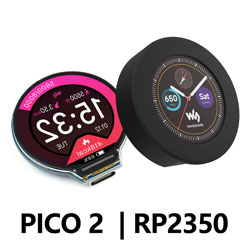- sales/support
Google Chat: zj734465502@gmail.com
- sales
+86-0755-88291180
- sales01
sales@spotpear.com
- sales02
dragon_manager@163.com
- support
tech-support@spotpear.com
- CEO-Complaints
zhoujie@spotpear.com
- sales/support
WhatsApp:13246739196
【MicroPython】machine.SPI Function
- machine.SPI(id,baudrate=1000000, polarity=0, phase=0, bits=8, firstbit=SPI.MSB, sck=None, mosi=None, miso=None)
- SPI object constructor, used to initialize the corresponding channel and pin
- id: use SPI channel, can be 0 or 1
- baudrate: SPI communication rate, which is the frequency on the SCK pin
- polarity: Clock polarity, if it is 0, SCK outputs a low level when the bus is idle, otherwise it outputs a high level.
- phase: the clock phase, if it is 0, the data is captured on the first clock edge, otherwise, the data is captured on the second clock edge.
- bits: the number of data bits per transfer
- firstbit: transmit high or low bits first
- sck: SCK pin, should be a Pin object
- mosi: MOSI pin, should be a Pin object
- miso: MISO pin, should be a Pin object
- sck, mosi and miso are all pins used by SPI and should be Pin objects
- SPI.init()
- init function, used to restart SPI
- SPI.deinit()
- deinit function, used to close the SPI
- SPI.read(nbytes,write=0x00)
- read function, used to read data from the device and return
- nbytes: number of bytes read
- write: When reading data, MOSI outputs data.
- SPI.readinto(buf,write=0x00)
- The readinto function is used to read data from the device and store it in the specified character array.
- buf: character array, used to store received data
- write: When reading data, MOSI outputs data.
- SPI.write(buf)
- write function, which writes a character array to the slave device.
- buf: character array, used to store transmission data
- SPI.write_readinto(write_buf, read_buf)
- write_readinto function for sending and receiving data at the same time
- write_buf: character array, used to store transmission data
- read_buf: character array, used to store received data
- PS: The length of the character array for transmitting and receiving data here is required to be consistent.
Demo Address
This article is only for RP2040 MicroPython firmware, and the source code shall prevail. This article is written according to the official source code at the time of writing, which is used to provide convenience for beginners and is for reference only. Those who are capable are recommended to refer to MicroPython.
TAG:
Raspberry Pi 3.97 inch e-Paper link BW 800x480 For Arduino / Jetson / STM32 /ESP32
ESP32 S3 4inch LCD Development Board 480x480 TouchScreen Display TVBOX LVGL HMI Sensor CAN RS485
Raspberry Pi 5 PCM5122 I2S Audio Card DAC Also For PI4 /PI3 /Zero Series
ADXL354BEZ
NVIDIA Jetson TX2 NX Module
USB-CAN-B
Spotpear
2.8inch Round LCD USB Monitor Computer Monitor Display Screen USB Type C Secondary Screen PC CPU GPU
RP204 0.85inch LCD
ESP32-S3 Mini
ESP32-S3 1.28inch Round LCD
Raspberry Pi Pico 2 RP2350B RP2350-PiZero Development Board PSRAM DVI For HDMI
Jetson
OLED-LCD-HAT-A
Raspberry Pi PICO LoRa-HF
Raspberry Pi 5 RTC charge
LuckFox Pico UART
ESP32 C3
Raspberry Pi 5 PCIe to M.2 NVMe SSD Adapter Board HAT Pi5-PCIe-MPS2242-2230-Board
1.54inch OLED
TAG:
Raspberry Pi 5 PCIe WIFI7
Chip RP2350A RP2350B RP2354A RP2354B Raspberry Pi Pico 2
Luckfox Pico Ethernet
Wireless RTL8822CE NIC 2.4G 5GHz Dual Band WiFi High Speed Wireless Card RTL8822CE-CG core
Raspberry Pi RP2040
Raspberry Pi 5 Argon NEO 5 M.2 NVME PCIE Case Pi5
ESP32-S3
Raspberry Pi 5 UART
Sipeed NanoKVM-USB
Raspberry Pi CM5 Mini Base IO Board NANO A Development For Compute Module 5
Raspberry Pi 5 ABS Case
NVIDIA Jetson Orin Nano/NX PoE Power over Ethernet RJ45 802.3af
ESP32 C3 MINI TV LVGL Astronaut Clock Watch Buzzer 1.69inch LCD TouchScreen Display ST7789 240x280
Raspberry Pi Pico 2 RP2350 Plus
LuckFox Pico UART
CPU
ESP32 P4 Development Board WIFI6 4 inch LCD Round Display 4inch TouchScreen 720×720 Dual Microphones
Raspberry Pi 5
ESP32 S3 R8 MP3 2.8inch LCD Captive TouchScreen Display LVGL Speaker RTC SD-Card-Port Battery-Port QMI8658-6-Axis-Sensor
Power




